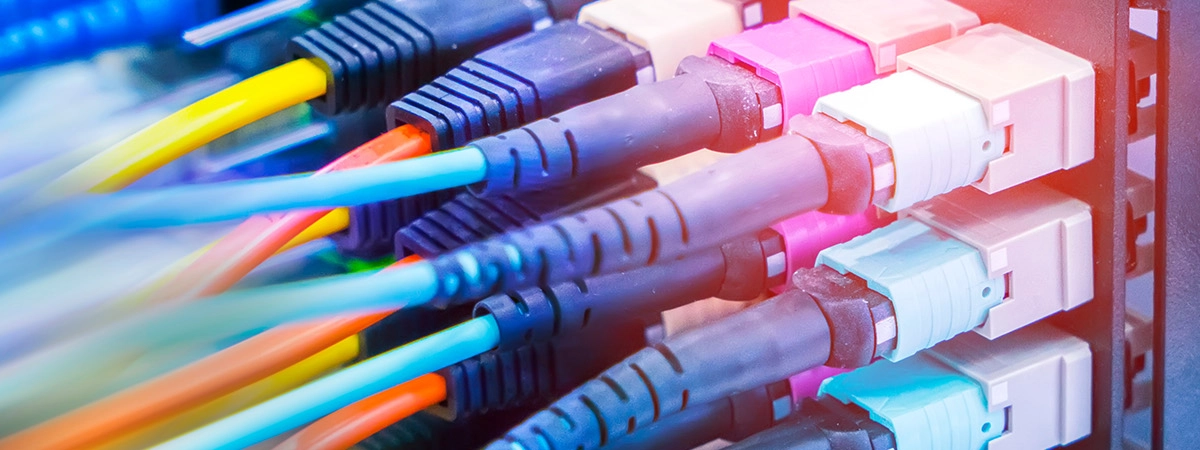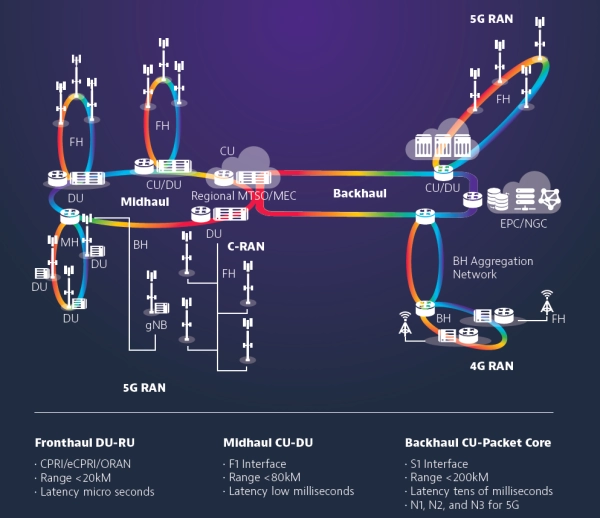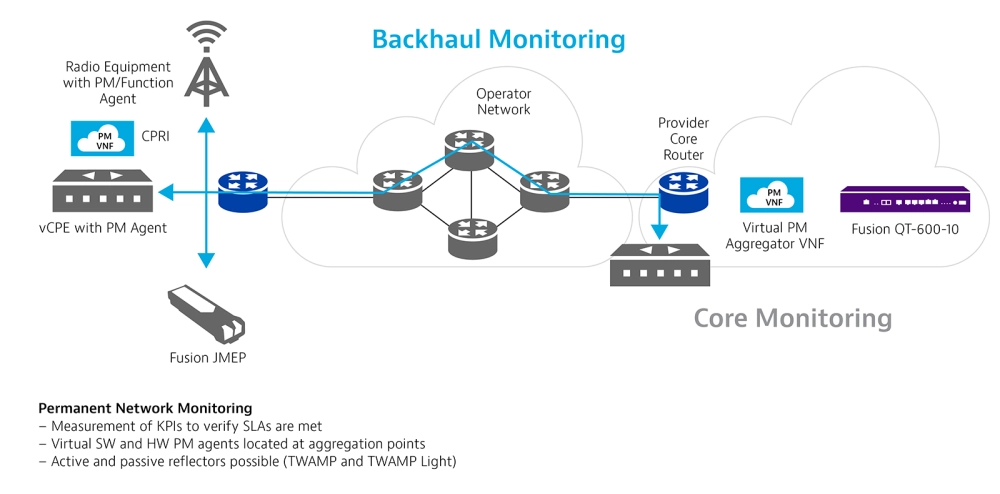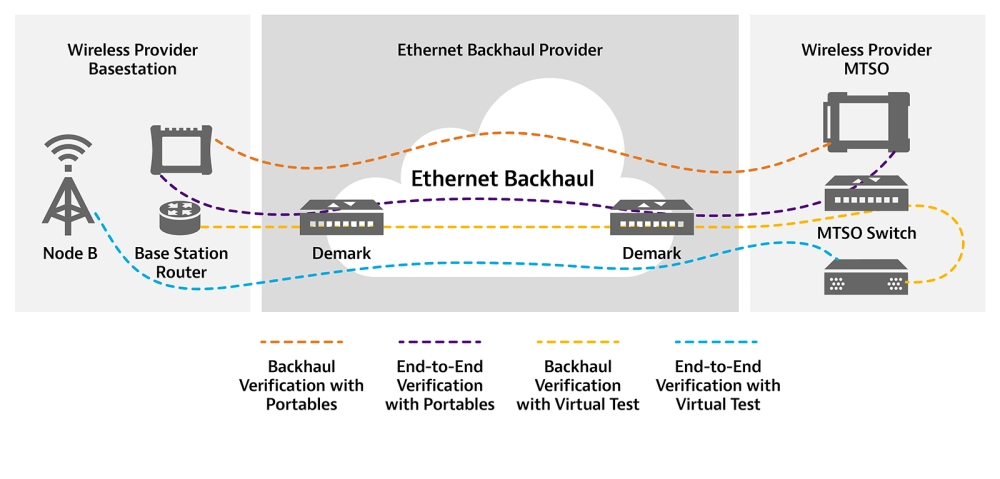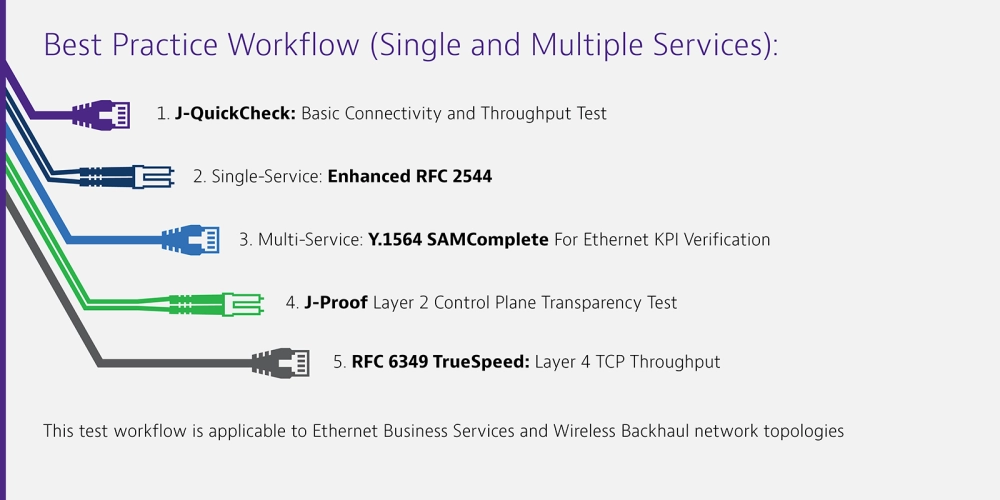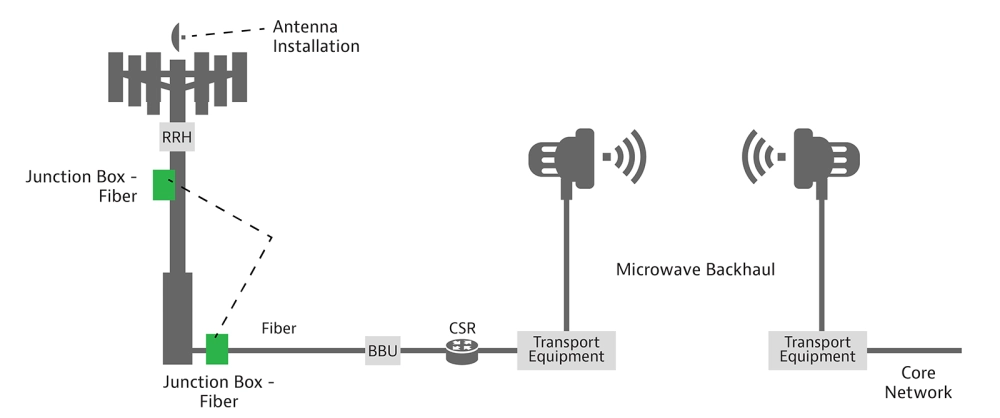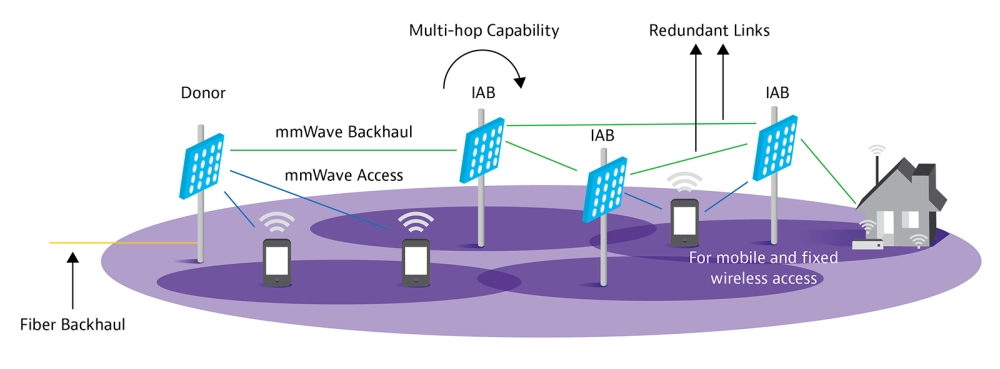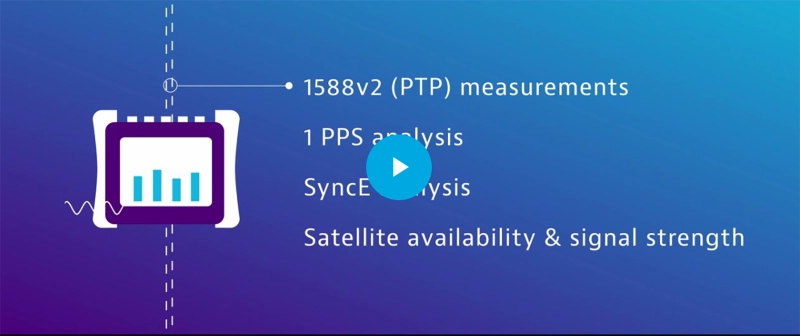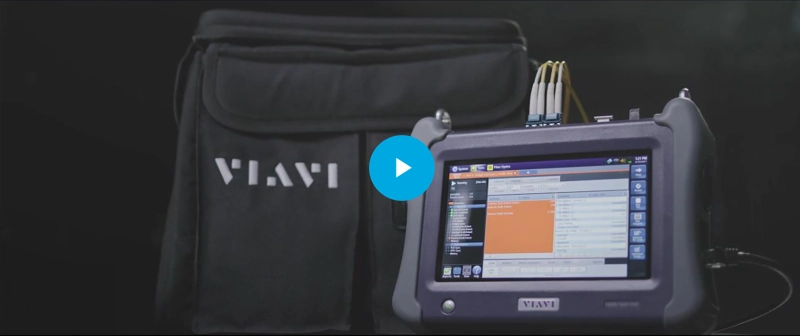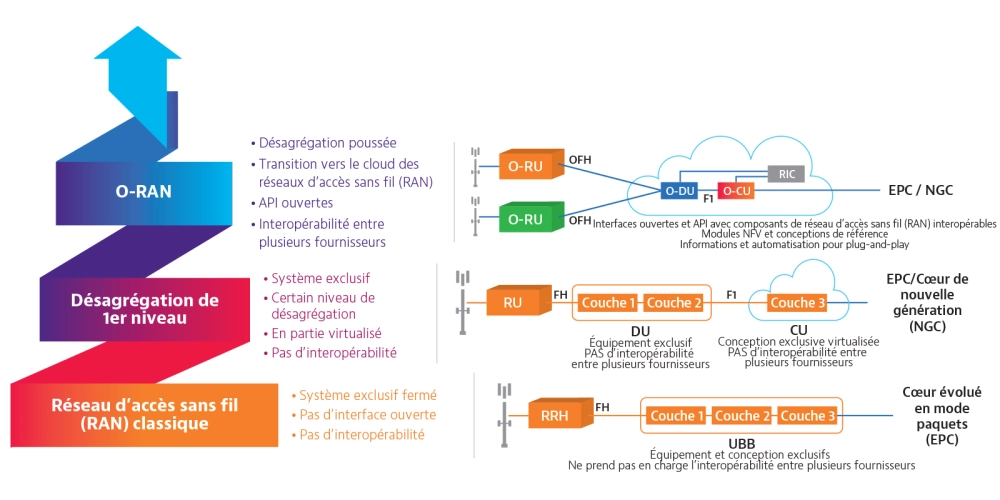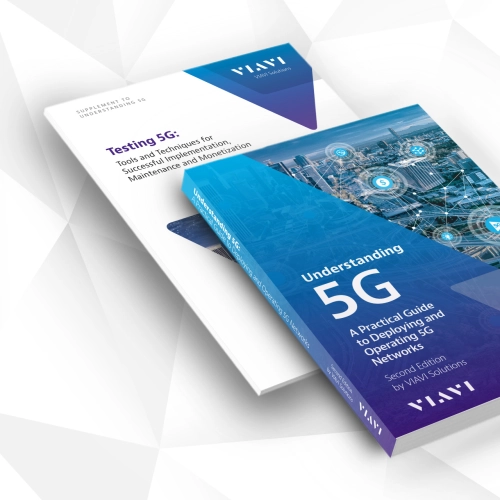Backhaul
Réacheminement du trafic mobile du RAN jusqu’au cœur
Backhaul
Dans le langage du transport, le terme backhaul (ou voyage de retour) désigne le retour à son point de départ d'un véhicule transportant une nouvelle charge marchande prélevée sur un site de départ. L'utilité de ce concept est aussi évidente dans le contexte des réseaux backhaul mobiles, les vrais « chevaux de trait » des télécommunications modernes.
Les réseaux 5G font peser des défis sans précédent sur la définition du backhaul. Alors que la technologie continue à évoluer tandis qu'émergent de nouveaux protocoles, débits de ligne et types de supports, VIAVI propose des solutions de test complètes du backhaul pour une activation de service et une gestion des performances efficaces. Les fonctionnalités d'automatisation du processus de test, de synchronisation des routines de test et d'inspection des connecteurs optiques intégrée garantissent les performances du backhaul tout au long du cycle de vie des services.
Qu'est-ce que le backhaul mobile ?
« Backhaul » est un terme générique qui décrit l'infrastructure de transport utilisée pour connecter le réseau d'accès sans fil (RAN) au cœur d'un réseau mobile. Cette liaison essentielle entre les antennes et le concentrateur du fournisseur est un composant central de l'infrastructure de réseau mobile.
Le développement de la technologie MIMO, la virtualisation des réseaux RAN et les modèles architecturaux divisés ont donné naissance au fronthaul et au midhaul qui complètent la définition classique du backhaul. La réunion des architectures de backhaul, de fronthaul et de midhaul est également appelée x-haul, le composant backhaul se distinguant par sa liaison le connectant au cœur.
Comment expliquer l'importance des réseaux backhaul ?
L'importance des réseaux backhaul est parfois sous-estimée alors que l'innovation RAN 5G et de nouvelles offres d'appareils portables sont lancées pour optimiser les opportunités offertes par la 5G. Les performances, la capacité et la fiabilité du backhaul sont essentielles pour répondre aux exigences de transport découlant de la connectivité 5G, de l'internet des objets (IdO) et du nombre croissant d'abonnés. La perte de paquets, la latence élevée et la gigue de la porteuse ne sont que quelques exemples des problématiques qui peuvent émerger si la disponibilité du backhaul n'a pas été prise en charge.
Pour éviter les problèmes affectant l'expérience utilisateur liés au backhaul du réseau et du Wi-Fi, les opérateurs ont cherché des solutions innovantes pour augmenter la bande passante et garantir l'intégrité des services. Les pratiques de surveillance et de test du backhaul mobile ont pris de plus en plus d'importance, les niveaux de service étant vérifiés lors de l'activation, puis constamment évalués et optimisés, alors que les capacités de dépannage réduisent les interruptions de service pour toute une gamme de nouveaux modes de transport backhaul.
L'impact de la 5G sur les réseaux backhaul
Chaque nouvelle génération de technologies mobiles accroît la pression sur les réseaux backhaul, même si l'impact actuel de la 5G est inégalé. La diversité des cas d'utilisation, le MIMO et le découpage réseau en tranche (Network Slicing) ont influencé le backhaul pour la 5G de manière tangible. La densification du réseau et la capacité de couverture réduite des ondes millimétriques exacerbent les défis du backhaul 5G.
Au débit de crête et aux vitesses de téléchargement pouvant atteindre 10 Gbit/s, des volumes de données exponentiellement plus élevés doivent être transportés par backhaul à partir d'un nombre infiniment supérieur d'emplacements. Les principaux cas d'utilisation de la 5G, parmi lesquels le haut débit mobile amélioré (eMBB), les communications massives entre machines (mMTC) et les communications ultra-fiables à faible latence (URLLC), sont rendus possibles grâce au découpage réseau en tranche et à la virtualisation des fonctions réseau (NFV) au sein des segments fronthaul et midhaul.
La configuration du fronthaul et du midhaul 5G peut être personnalisée en fonction des exigences de latence, de bande passante et de synchronisation des cas d'utilisation. La charge de la latence pour les liaisons backhaul 5G a ainsi diminué et toute l'attention se focalise à présent sur la capacité, l'efficacité spectrale et l'orchestration des services pour prendre en charge de manière dynamique les exigences des cas d'utilisation de la 5G.
Technologies de backhaul
Depuis le premier raccordement des réseaux mobiles aux backbones à l'aide d'un câble coaxial, la technologie de backhaul a été le reflet de l'évolution des supports de transport et de la croissance ininterrompue du trafic qui caractérisent l'ère des télécommunications. L'adoption continue de nouveaux protocoles de transmission et d'infrastructures permet aux réseaux backhaul de garder une longueur d'avance sur la demande.
La technologie de multiplexage temporel (TDM) est apparue dans les années 1980 et a donné naissance à un nouveau mode de transport backhaul précoce qui a supplanté le câble coaxial. Également appelées backhaul commuté par circuit ou point à point, les méthodes TDM divisent les services clients en créneaux de temps discrets. Ces affectations de temps sont commutées via le réseau pour gérer de manière fiable les demandes de bande passante et de performance de chaque service. La méthode de backhaul TDM nécessite un délai précis pour fonctionner correctement.
Alors que les services de base, comme le texte et la voix, se sont vus éclipser par la transmission des données sans fil via le LTE et la 5G, l'évolutivité des technologies de transport orientées connexion et commutées par circuit a diminué. Le déploiement du backhaul a évolué vers une approche basée sur les paquets qui correspond à l'architecture globale de réseau mobile. Cela étant, plusieurs pays continuent d'utiliser la technologie TDM pour le backhaul.
Les protocoles Ethernet basés sur les paquets prennent efficacement en charge le backhaul pour la 5G. Les débits binaires et les distances des liaisons ont augmenté avec l'introduction du protocole Ethernet basé sur la fibre optique et les limites de bande passante ont été réduites. Pour pallier le manque de synchronisation de fréquence précise d'Ethernet du backhaul TDM, l'IEEE a développé le protocole de précision temporelle (PTP) pour prendre en charge la synchronisation Ethernet, y compris les liaisons backhaul longue distance. Cette exactitude est primordiale pour les cas d'utilisation de la 5G comme les voitures autonomes qui reposent sur une temporalité précise et un très faible niveau de latence.
Alors que le backhaul à fibre optique évolue vers Ethernet et que de nouvelles installations émergent, des solutions de test compactes compatibles avec les technologies de backhaul existantes et émergentes garantissent la polyvalence et l'efficacité des tests. Le testeur de réseau portable MTS 5800 intègre des fonctions avancées de caractérisation de la fibre optique, d'activation, de synchronisation et de délai de réseau et de dépannage pour les connexions Ethernet aussi bien que backhaul TDM. Les fonctionnalités intégrées de test du délai/de la synchronisation vérifient la conformité aux normes IEEE PTP.
Parmi les options de backhaul mobile sans fil, le backhaul par faisceau hertzien s'est imposé comme une technologie incontournable avec ses coûts de déploiement intrinsèquement faibles et son immunité relative face aux interférences ou aux dégradations physiques. Le spectre des micro-ondes loué peut être utilisé pour transporter par backhauler plusieurs services par voie hertzienne avec un investissement minimal. La modulation d'amplitude en quadrature (QAM), la jonction des liaisons radio et d'autres innovations ont été utilisées pour optimiser la capacité du backhaul hertzien. Grâce à une évolutivité élevée et à une efficacité compatible avec les exigences des réseaux 5G, le backhaul hertzien s'impose comme un composant essentiel des réseaux backhaul mobiles de 10 Go. Le backhaul hertzien est encore largement répandu dans les zones non éligibles à la fibre optique.
L'expression réseau optique passif (PON) désigne une configuration de réseau de fibre optique point à multipoint qui utilise la fibre optique, des coupleurs et des multiplexeurs non alimentés. La technologie PON a souvent été déployée pour les applications fibre à l'abonné (FTTH) et fibre jusqu'au bâtiment (FTTB) avant de prendre récemment conscience de ses avantages pour les applications de réseaux fronthaul et backhaul.
Les réseaux PON utilisant un modèle de fibre optique partagé composé de composants passifs peuvent atteindre un débit de 10 Gbit/s et la faible latence requise pour la 5G. La division PON est reconnue comme étant une solution logique pour distribuer la bande de base 5G aux têtes radio distantes. L'intégration d'éléments PON dans les réseaux backhaul mobiles va se poursuivre avec l'amélioration de la technologie.
Les déploiements à haute fréquence associés à la 5G sont malheureusement coûteux et ont une couverture limitée. Le déploiement de la fibre optique constitue un enjeu majeur en termes de coûts et de temps. L'architecture d'accès et backhaul intégrés (IAB) constitue une alternative permettant d'éviter les coûts et les délais importants liés à l'installation de la fibre optique en utilisant une partie du spectre sans fil pour la connexion backhaul des stations de base à la place de la fibre optique. Le spectre de la 5G constitue par ailleurs une ressource utile. Les porteuses peuvent en effet souhaiter en exploiter une partie sur un court laps de temps pour colmater une faille de couverture ou pour étendre la couverture au niveau d'une autoroute ou pour des évènements intrinsèquement temporaires, comme les concerts, les manifestations sportives, etc.
Quels sont les problèmes courants du backhaul ?
En matière de performance, les réseaux backhaul sont exposés aux mêmes facteurs de risque que les autres réseaux câblés et mobiles. Les liens fibre optique peuvent subir des dommages physiques involontaires ou être soumis aux intempéries et à des violations de la sécurité (intrusions). Les segments du backhaul Ethernet, même s'ils sont plus performants en termes de capacité et de coût, doivent renfermer des informations sur le délai et la synchronisation du réseau. Une mauvaise synchronisation du réseau provoque des interférences entre les pylônes voisins, des abandons d'appels et une diminution du débit de transmission de données. Les réseaux mobiles sont exposés à un risque d'interférences, de limites de la distance de transmission et de visibilité directe (LoS). Si un problème du réseau backhaul n'est pas résolu, une latence, une gigue ou des pertes de paquets peuvent être observées et avoir un impact sur l'expérience utilisateur et les niveaux de satisfaction.
Outre les problèmes liés au réseau backhaul mobile préexistant, la prolifération des small cells, les exigences de débit et les enjeux liés à l'augmentation massive du trafic générés par l'émergence de la 5G continuent à mettre la barre encore plus haut. En dépit d'un large consensus concernant ces problématiques, chaque opérateur propose une solution de réseau mobile 5G spécifique. L'agrégation du backhaul aux « super cells », le réseau backhaul mobile dans les ondes millimétriques et le nombre illimité de solutions holistiques méritent d'être pris en compte.
Pourquoi faut-il tester le backhaul ?
Les précédentes générations de technologie backhaul mobile étaient conçues pour prendre en charge l'infrastructure macrocellulaire de manière prévisible. Suite à l'évolution du réseau TDM vers l'Ethernet/IP et le remplacement du modèle macrocellulaire classique par les small cells, l'architecture de la station de base et les stratégies de gestion du trafic se sont adaptées. Ces changements progressifs ont modifié les stratégies de test des réseaux backhaul mobiles en passant d'une approche de vérification ponctuelle à une surveillance continue des performances.
Les cas d'utilisation de la 5G comportant de strictes exigences de latence et de débit ont fait disparaître les marges d'erreur existant précédemment. Le protocole Ethernet basé sur les paquets a rationalisé le flux de données du réseau backhaul, même si les taux d'erreur binaire (TEB) et les pertes de paquets doivent rester très faibles pour prendre en charge les applications à traitement de données intensif comme l'intelligence artificielle (IA) et la réalité augmentée (RA). Le test du backhaul et la surveillance des mesures de performance au fil du temps peuvent éviter rapidement l'apparition d'éventuels problèmes et accélérer les procédures de dépannage.
Synchronisation temps et phase du réseau
Une synchronisation fiable des horloges est devenue primordiale pour la migration des réseaux backhaul mobiles vers les réseaux basés sur les paquets. Des techniques de synchronisation basées sur les paquets, telles que PTP/IEEE 1588v2, sont requises pour fournir aux dispositifs situés à la périphérie du réseau des signaux de synchronisation sur l'ensemble des réseaux IP. Une synchronisation insuffisante au niveau de l'antenne cellulaire génère des interférences RF, lesquelles altèrent la qualité des appels, augmentent le nombre d'abandons d'appels lors des transferts, imposent des délais de configuration des appels excessifs, réduisent la bande passante et entraînent une utilisation inefficace du spectre. Les porteuses sans fil sont en concurrence en ce qui concerne tous ces problèmes de qualité fondamentaux pour les clients et réalisent des investissements se chiffrant en millions, voire en milliards, de dollars pour acheter des licences de spectre. Il est donc facile de comprendre pourquoi une synchronisation stricte des réseaux revêt une importance vitale pour elles.
Les nouvelles méthodologies fournissent heureusement des tests de synchronisation simples, disponibles sur les instruments de terrain utilisés pour tester le backhaul et le fronthaul. Les applications de test GPS vérifient la position correcte des antennes en contrôlant le nombre de satellites visibles et la force de leurs signaux respectifs. Le test PTP/IEEE 1588v2 vérifie la fiabilité de la connexion des antennes-relais aux horloges principales (ou grandmasters) et qualifie le réseau backhaul pour la mise à disposition appropriée de la synchronisation en vérifiant le délai, les variations de délai, les erreurs de temps, les dérapages et les écarts de fréquence des signaux d'horloge PTP, Ethernet Synchrone et 1pps/10 MHz/BITS/SETS.
Procédure de test d'un réseau backhaul
La complexité croissante de la technologie backhaul et l'augmentation exponentielle de la demande rendent logique et rentable l'adoption d'une approche complète du cycle de vie du test du backhaul. Les exigences de performance du backhaul sont rapidement transférées des planches à dessin à des solutions mobiles et à des conceptions qui doivent être déployées rapidement, en toute sécurité et à moindre coût.
Objectifs de service
Des objectifs de service formels constituent le premier jalon pour évaluer la satisfaction des clients. Chaque site possède ses propres accords de niveau de service, objectifs de couverture et prévisions d'utilisation du backhaul qui conditionnent l'architecture, la capacité et les exigences de test du backhaul.
Conjointement à ces objectifs clairement définis, la réalisation d'une inspection des connecteurs optiques et d'une qualification avant la mise en service constitue un autre jalon du déploiement. Les solutions portables innovantes, telles que INX 760 Probe Microscope de VIAVI, prennent en charge les tests des réseaux backhaul mobiles et la certification de la fibre optique au moyen de capacités d'inspection entièrement autonomes des connecteurs multifibres et de certification des connecteurs optiques dans un dispositif portable convivial.
Activation de service
L'activation de service constitue une phase importante dans la procédure de test du backhaul lorsque les antennes-relais testées fournissent un premier aperçu des niveaux de service et des référentiels de performance réels. Les outils de test automatisés rationalisent la caractérisation des liens fibre optique du backhaul et la mise en service d'Ethernet conformément aux spécifications RFC 2544 et Y.1564. Un diagnostic rapide des problèmes de débit, de pertes de trames et de latence peut accélérer le dépannage et éviter qu'un dysfonctionnement du backhaul ne retarde la certification d'un site. Le testeur MTS 5800 de VIAVI est l'outil idéal pour tester les segments du backhaul dans la mesure où il permet de tester plusieurs couches du réseau et types de protocoles, ainsi que les délais et la synchronisation.
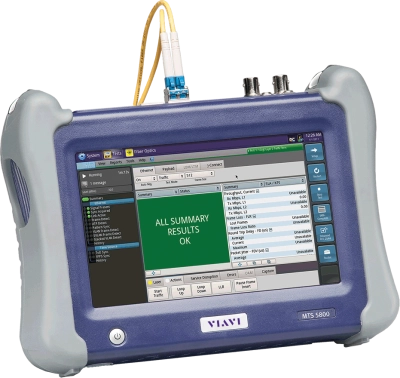
Assurance/Gestion de la performance du backhaul
Les conséquences économiques d'une détérioration du backhaul peuvent être dramatiques. C'est pourquoi la gestion continue des performances et la détermination des tendances en matière de KPI (Key Performance indicator) pour l'ensemble des liaisons backhaul sont devenues incontournables. Les solutions automatisées de surveillance de la fibre optique, les options d'assurance de transport et une nouvelle génération de microsondes fonctionnent conjointement pour détecter instantanément les défauts, les cas de dégradation ou les intrusions et pour déclencher des alarmes. Avec les déploiements de réseaux backhaul hybrides intégrant les meilleures technologies de transmission pour répondre aux normes de la 5G, les solutions de surveillance et de test avancées pour les réseaux backhaul mobiles de 10 Go constituent un autre élément de test essentiel.
L'avenir du X-Haul 5G
À mesure que les opérateurs transforment progressivement leurs déploiements 5G en passant d'un mode de non autonome à un mode autonome, les cas d'utilisations dépassant l'eMBB tant attendus se concrétiseront. La connexion des réseaux 5G NR aux réseaux principaux 5G, le MIMO massif (Massive MIMO), le découpage réseau en tranche (Network Slicing)et la transmission des ondes millimétriques libèrent pleinement le potentiel de la technologie 5G.
Alors que les services 5G renforcent la demande de 5G, l'impact sur les futurs réseaux x-haul sera important. Un utilisateur de la 5G en mode autonome consomme jusqu'à 10 fois plus de bande passante qu'un utilisateur LTE. Pour relever ce défi de manière proactive, une réflexion originale sera nécessaire pour compléter la simple multiplication des liaisons backhaul mobiles et Ethernet existantes. Les normes Open RAN constituent une partie de la solution en accroissant l'efficacité par le biais de l'interopérabilité, de la convergence et de la concurrence du marché.
En scindant la technologie de backhaul classique en segments fronthaul, midhaul et backhaul configurables, le x-haul a apporté une solution capable de répondre aux attentes. Les nouvelles innovations telles que les réseaux quantiques pourraient permettre de dresser une analogie entre la technologie 5G x-haul et les camions surchargés du siècle dernier qui ramenaient du gravier dans la carrière. Les fonctions de test et de surveillance performantes adaptées à l'étendue, à la flexibilité et au cycle de vie des réseaux backhaul mobiles vont continuer à garantir des niveaux de service et de satisfaction élevés pour les futures générations.
Laissez-nous vous aider
Nous sommes là pour vous aider à prendre une longueur d’avance.
